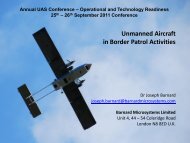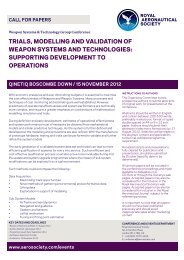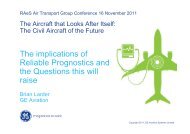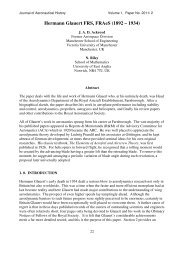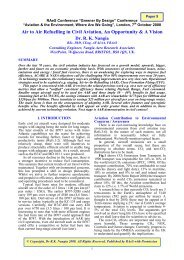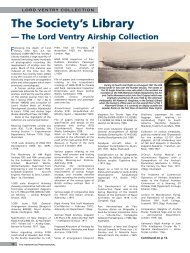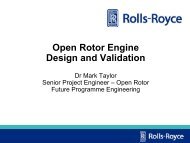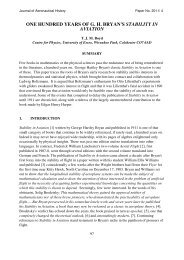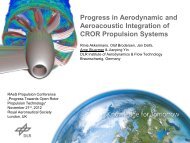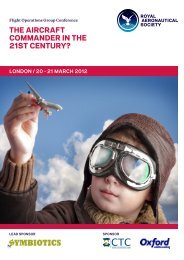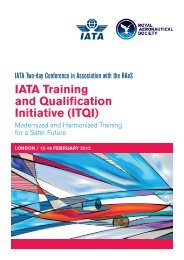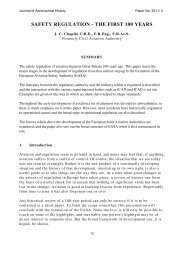Smoke, Fire and Fumes in Transport Aircraft - Royal Aeronautical ...
Smoke, Fire and Fumes in Transport Aircraft - Royal Aeronautical ...
Smoke, Fire and Fumes in Transport Aircraft - Royal Aeronautical ...
You also want an ePaper? Increase the reach of your titles
YUMPU automatically turns print PDFs into web optimized ePapers that Google loves.
warn<strong>in</strong>gs 94. The 14 CFR Part 25.858 (a) (<strong>and</strong> EASA/JAA) requires that<br />
detection system must provide a visual <strong>in</strong>dication to the flight crew<br />
with<strong>in</strong> one m<strong>in</strong>ute after the start of the fire. There is a compromise<br />
between speed of the warn<strong>in</strong>g <strong>and</strong> the susceptibility to false warn<strong>in</strong>gs.<br />
The FAA Technical Center studied the ratio of false warn<strong>in</strong>gs <strong>in</strong> cargo<br />
compartments to actual smoke or fire events <strong>in</strong> 2000. They found that<br />
the false alarm rate was <strong>in</strong>creas<strong>in</strong>g at that time 95. The rate of false<br />
warn<strong>in</strong>g is too high <strong>and</strong> improvements <strong>in</strong> the reliability of smoke<br />
<strong>and</strong>/or detectors should be sought.<br />
Multi-source sensors<br />
False eng<strong>in</strong>e fire warn<strong>in</strong>gs plagued pilots <strong>in</strong> the past. Modern jets now<br />
use a dual loop system to provide redundancy <strong>and</strong> reduce the<br />
potential for false fire warn<strong>in</strong>gs. Dual loop systems require fire to be<br />
sensed on both systems before illum<strong>in</strong>at<strong>in</strong>g the fire warn<strong>in</strong>g on the<br />
flight deck. This improved system also has the benefit of improv<strong>in</strong>g<br />
the dispatch reliability by hav<strong>in</strong>g a redundant system. The idea of<br />
redundancy demonstrated by dual loop systems could be used <strong>in</strong><br />
cargo <strong>and</strong> other fixed detection systems.<br />
Another technology to reduce false warn<strong>in</strong>gs while provid<strong>in</strong>g rapid<br />
warn<strong>in</strong>g is us<strong>in</strong>g two different types of sensors (e.g. smoke <strong>and</strong><br />
thermal) with an algorithm to <strong>in</strong>terpret <strong>in</strong>puts <strong>in</strong> order to determ<strong>in</strong>e a<br />
nuisance <strong>in</strong>put from a real fire.<br />
Cargo compartments on aircraft manufactured up to 2005 have only<br />
s<strong>in</strong>gle source fire detectors. Some manufacturers have proposed<br />
us<strong>in</strong>g multi-source sensors <strong>in</strong> new aircraft 96. This technology<br />
dramatically reduces the possibility of false fire warn<strong>in</strong>gs. Us<strong>in</strong>g<br />
similar technology, now that it is proven, should be considered for<br />
application is other areas of the aircraft. Detection of a fire <strong>in</strong> the vast<br />
<strong>in</strong>accessible areas of the aircraft should use multi-source sensors.<br />
Protective Equipment<br />
Recommendation: Implement vision assurance technology for<br />
improved pilot visibility dur<strong>in</strong>g cont<strong>in</strong>uous smoke <strong>in</strong> the flight deck.<br />
Pilot vision dur<strong>in</strong>g a smoke event is essential. The FAA’s Aviation<br />
Safety Report<strong>in</strong>g System (ASRS) has numerous pilot reports of<br />
restricted visibility dur<strong>in</strong>g smoke events. Some pilots report smoke so<br />
thick that they could not see each other 97.<br />
Follow<strong>in</strong>g Air Canada Flight 797, the FAA required the <strong>in</strong>stallation of<br />
Protective Breath<strong>in</strong>g Equipment (PBE) on all 14 CFR Part 121<br />
aircraft. As 14 CFR Part 25.1439(b)(1) 98 states, <strong>in</strong> pert<strong>in</strong>ent part, that<br />
PBE must be designed to protect the flight crew from smoke, carbon<br />
dioxide <strong>and</strong> other harmful gases, while on the flight deck <strong>and</strong> while<br />
combat<strong>in</strong>g fires <strong>in</strong> cargo compartments. The need for visibility to<br />
combat the fire was <strong>in</strong>cluded <strong>in</strong> the justification for the need for PBEs.<br />
There is a similar need for pilot visibility to fly the aircraft dur<strong>in</strong>g<br />
cont<strong>in</strong>uous smoke events.<br />
The visibility must be enough to see the attitude <strong>in</strong>dicator or primary<br />
flight display <strong>and</strong> to see outside the aircraft for l<strong>and</strong><strong>in</strong>g. In addition, the<br />
pilots must see <strong>in</strong>struments to navigate <strong>and</strong> they must see to program<br />
the flight management computer, if <strong>in</strong>stalled. The checklist must be<br />
visible so that procedures can be followed to prepare for l<strong>and</strong><strong>in</strong>g <strong>and</strong><br />
fight the smoke/fire/fumes. Adequate visibility on the flight deck<br />
should be ma<strong>in</strong>ta<strong>in</strong>ed dur<strong>in</strong>g a smoke/fire/fume event.<br />
Head-Up Display<br />
Head-up display (HUD) technology is a grow<strong>in</strong>g addition to the civil<br />
transport fleet. Many new aircraft have HUDs available <strong>and</strong> some<br />
older aircraft are be<strong>in</strong>g retrofitted.<br />
BAE Systems has done research to take that technology <strong>and</strong> adapt it<br />
to the environment of smoke on the flight deck. A 1998 study by<br />
Embry-Riddle for BAE Systems showed that the visibility of the HUD<br />
rema<strong>in</strong>ed viewable for much longer that the Electronic Flight<br />
Instrument Systems (EFIS) display. This visibility difference could<br />
make a major difference <strong>in</strong> the outcome of a smoke event.<br />
The use of the HUD elim<strong>in</strong>ates the need to open the w<strong>in</strong>dow to<br />
improve visibility, thereby ma<strong>in</strong>ta<strong>in</strong><strong>in</strong>g the ability of the flight<br />
crewmembers to communicate with each other. If two HUDs are<br />
<strong>in</strong>stalled, there is the ability to monitor the fly<strong>in</strong>g pilot’s performance,<br />
which is an important element of transport aircraft operations. A s<strong>in</strong>gle<br />
HUD <strong>in</strong>stallation does not allow the First Officer to monitor the<br />
Capta<strong>in</strong> unless the normal flight <strong>in</strong>struments are visible.<br />
While this technology provides improvement <strong>in</strong> visibility over the<br />
st<strong>and</strong>ard flight <strong>in</strong>struments or EFIS, it does not provide improvement<br />
<strong>in</strong> the ability to see outside the aircraft. This limitation is important, as<br />
there are examples of fire caus<strong>in</strong>g the flight <strong>in</strong>struments to fail. This<br />
dependence of aircraft electrical power could allow this type of failure<br />
to affect the HUD <strong>and</strong> require the pilot to look at the natural horizon<br />
for attitude reference.<br />
HUD is an improvement <strong>in</strong> the vision available to pilots but its cost is<br />
high <strong>and</strong> it has operational limitations.<br />
Emergency Vision Assurance System<br />
The need for clear vision <strong>in</strong> a smoke filled flight deck can be met <strong>in</strong><br />
many cases by a clear plastic bubble filled with clear air. This device<br />
is known as Emergency Vision Assurance System (EVAS). Like the<br />
HUD, it provides the pilot with the ability to see critical flight<br />
<strong>in</strong>struments regardless of the density of smoke. It has the additional<br />
advantage of provid<strong>in</strong>g clear vision to the w<strong>in</strong>dshield.<br />
EVAS is a clear plastic device that allows a pilot to place his/her<br />
goggles <strong>and</strong> mask aga<strong>in</strong>st the unit <strong>and</strong> see the flight <strong>in</strong>struments <strong>and</strong><br />
outside the w<strong>in</strong>dshield. The unit <strong>in</strong>flates <strong>in</strong> less than 30 seconds,<br />
us<strong>in</strong>g a self conta<strong>in</strong>ed battery <strong>and</strong> blower, thereby not be<strong>in</strong>g<br />
dependent on the aircraft's electrical system. The flight deck air is<br />
filtered <strong>and</strong> cleaned of smoke then used to <strong>in</strong>flate the device. Like the<br />
HUD, this device elim<strong>in</strong>ates the need of open<strong>in</strong>g a w<strong>in</strong>dow <strong>and</strong><br />
therefore avoids <strong>in</strong>terfer<strong>in</strong>g with flight crew communications.<br />
It is possible that improved vision of the flight <strong>in</strong>struments <strong>and</strong> the<br />
w<strong>in</strong>dshield would have allowed Varig Flight 860 to l<strong>and</strong> on the runway<br />
<strong>in</strong>stead of <strong>in</strong> a field. This is the most dramatic example of potential<br />
improvements with vision assurance technology, but others, such as<br />
Air Canada Flight 797, Pan American Flight 160 <strong>and</strong> the Air Europe<br />
Fokker l<strong>and</strong><strong>in</strong>g <strong>in</strong> Copenhagen may also be have been positively<br />
affected.<br />
In a smoke filled flight deck, the ability of the non-fly<strong>in</strong>g pilot to monitor<br />
the other pilot is dependent on his/her ability to see the flight<br />
<strong>in</strong>struments <strong>and</strong> if they are function<strong>in</strong>g.<br />
This monitor<strong>in</strong>g activity is a fundamental part of transport aircraft<br />
tra<strong>in</strong><strong>in</strong>g <strong>and</strong> operations. EVAS allows pilot monitor<strong>in</strong>g to cont<strong>in</strong>ue<br />
dur<strong>in</strong>g smoke/fire/fume events thereby ma<strong>in</strong>ta<strong>in</strong><strong>in</strong>g normal pilot<br />
redundancy.<br />
Recommendation: Provide full-face oxygen masks <strong>and</strong> sufficient flight<br />
crew oxygen for descent <strong>and</strong> l<strong>and</strong><strong>in</strong>g dur<strong>in</strong>g a smoke/fire/fume event.<br />
Flight crews must be protected from toxic fumes to safely fly <strong>and</strong> l<strong>and</strong><br />
their aircraft. Protect<strong>in</strong>g the crew primarily consists of oxygen masks<br />
<strong>and</strong> smoke goggles. Provid<strong>in</strong>g an <strong>in</strong>dependent oxygen source <strong>and</strong><br />
clean air for protection for the eyes of the crew is essential. In the past<br />
smoke goggles have been found to be ill fitt<strong>in</strong>g <strong>and</strong> not provid<strong>in</strong>g a<br />
FEBRUARY 2007 15



